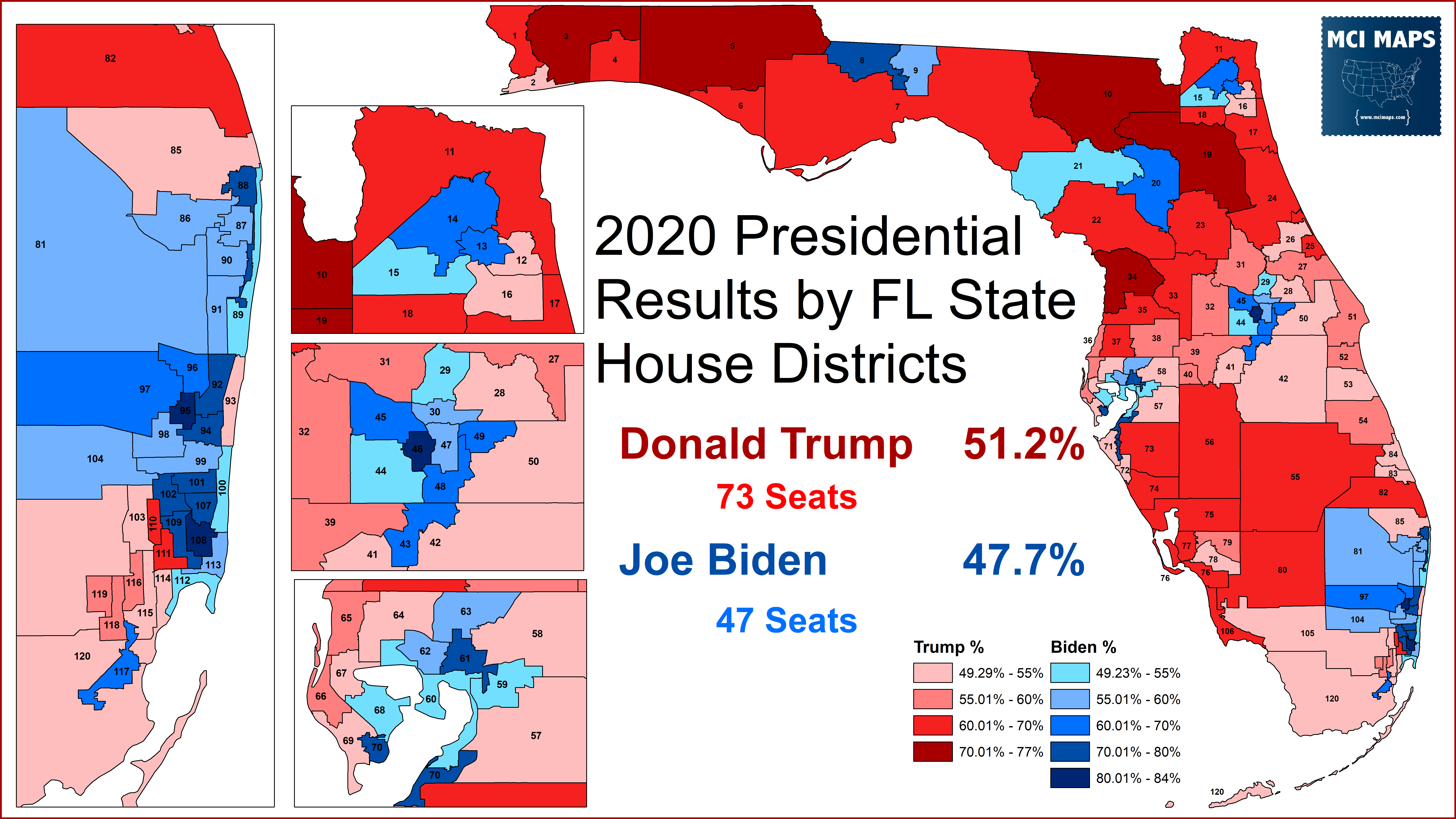In November of 2020, Donald Trump won Florida in his failed re-election bid. He took the state by 3.3% – which was the largest margin since Georgia W Bush’s 2004 win. The win was primarily thanks to holding the working-class voters he gained in 2020 and major gains with Hispanic voters, as well as more modest gains with other non-white voters. Biden made gains in several suburbs, flipping historically-red Seminole and Duval county, and making some narrow working class gains. The precinct-digging into Florida is being done by many data researchers and myself, and more will be written here in the future. For this article, I wanted to focus on the results by State House District. I will look at how the Presidential results broke down by each district – and how the state house results came out.
How the District’s Voted
In 2020, Trump’s 1% win in Florida translated to winning 66/120 districts. The house map, drawn by the GOP majority in 2012, consistently leans right of the nation as a whole. Obama lost a majority of districts even as he won re-election in Florida in 2012. Trump’s narrow 2016 win resulted in a 12 seat gap between him and Clinton.
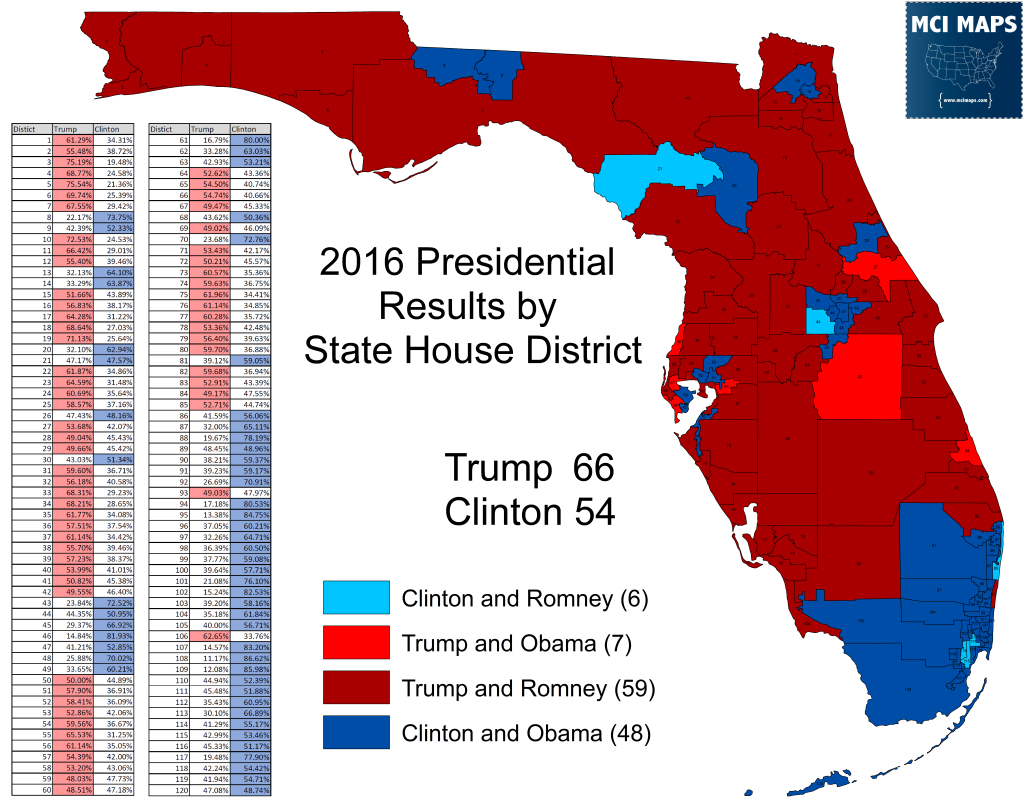
In the five statewide elections in 2018, the GOP won in a majority of seats. The lone Democratic winner, Nikki Friend, got to 57 seats, still below a majority. Meanwhile, the 6% GOP win for Attorney General resulted in getting 76 districts.
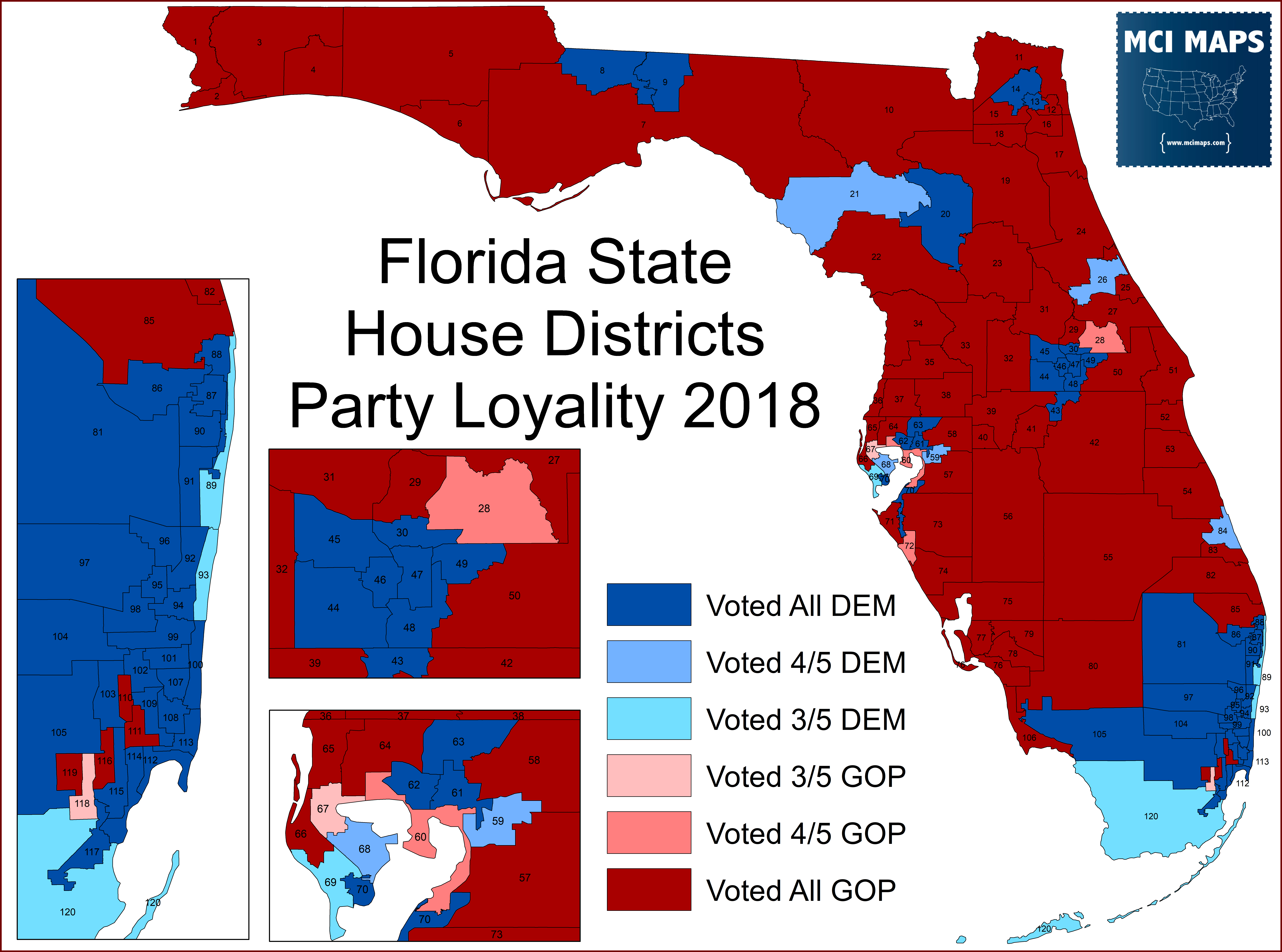
Trump’s 3.5% win this time led to a massive gain in seats vs 2016. Trump took 73 of the seats, leaving Biden with just 47. This is the biggest seat gap for this map in any Presidential election so far. Biden’s seats were limited to the major cities and southeast, while Trump won everywhere else.
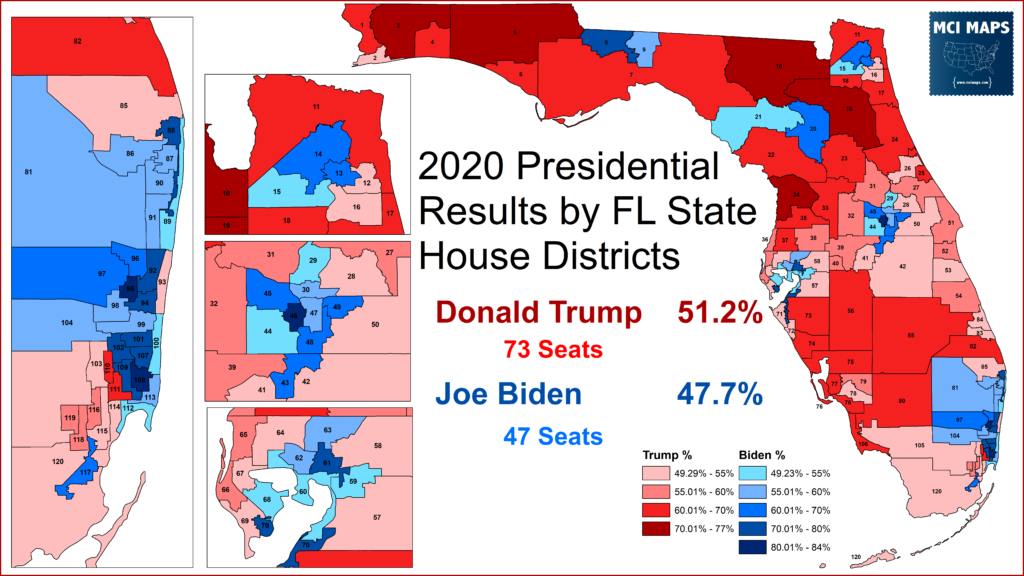
In total, 15 districts changed from 2016. Biden flipped four districts; all of them suburban or urban. Meanwhile, Trump flipped 11 districts, one was a working-class seat in Volusia, and 10 being Hispanic-aligned seats in Miami-Dade.

The swing map from 2016 shows Biden’s problems with Hispanic voters in clear detail – with massive swings not only in Dade but in Hispanic-heavy districts of central Florida like the 48th, 43rd, and 62nd. The map also shows Biden losing ground in the working-class districts around Hernando and Volusia; as well as rural districts like the 7th, 10th, and 55th. Biden’s best gains were centered in suburbs, some retiree areas, and the military-heavy western panhandle. In many cases, Biden’s suburban gains were not strong enough. Districts like the 72nd, 28th, 29th, 63rd, 60th, and 89th should have seen much larger suburban swings to counter even a more modest Hispanic drop.
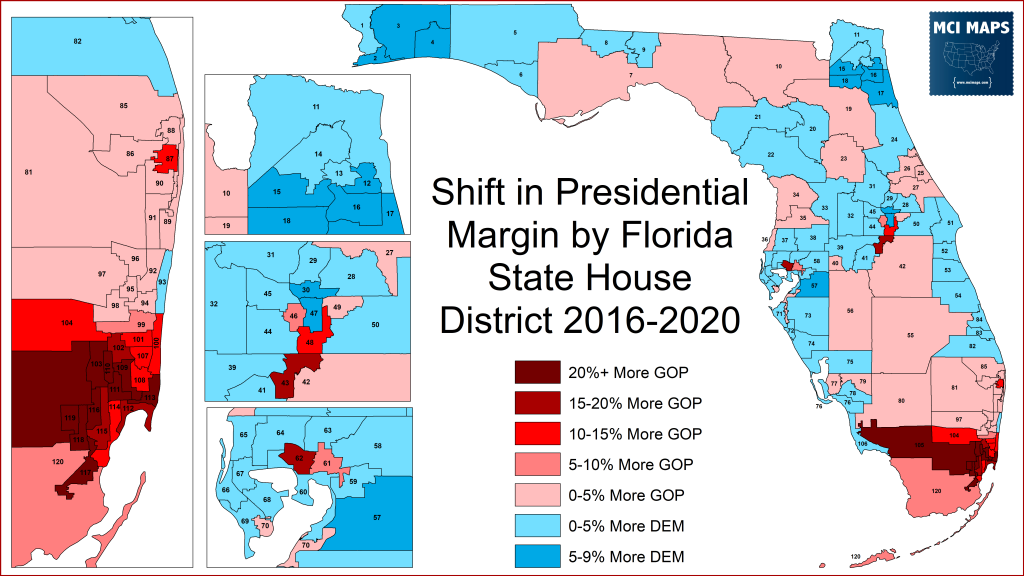
How these districts all voted – including the 2016 comparison – is visible below.
The flip of almost all the Hispanic Dade seats is the most dramatic single-election flip in modern Florida. In 2016, Clinton had broken records by winning every Dade-based seat (Obama had lost a couple in 2012). This time 10 went to Trump.
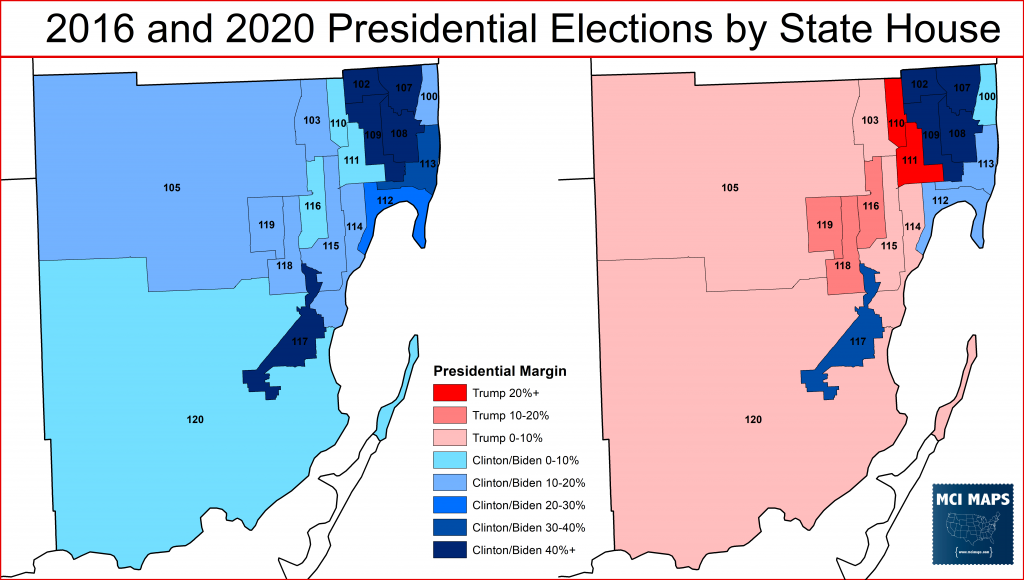
You can see the precinct-level swing below, with house lines overlaid on top.
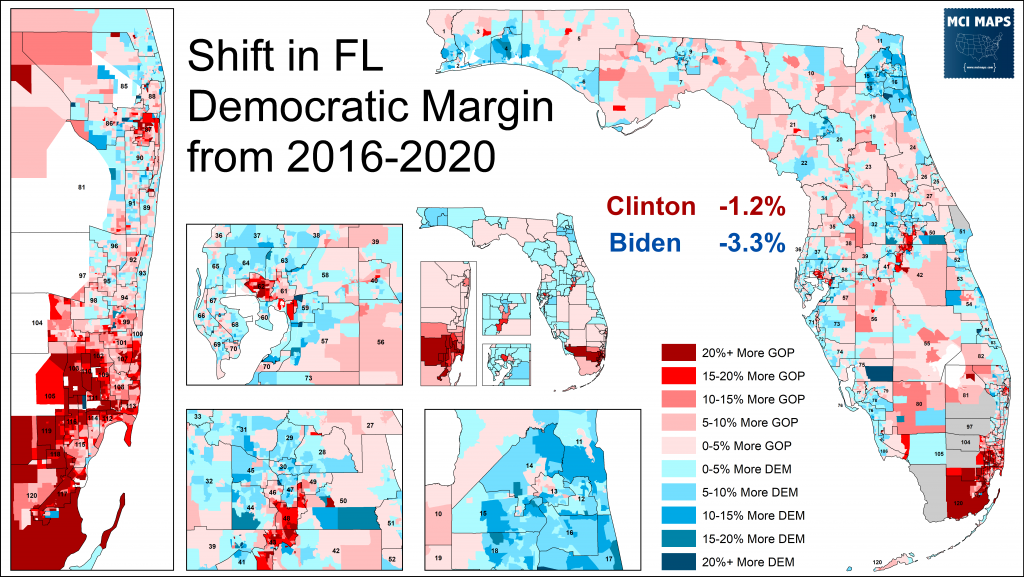
The next map shows how Biden did compared to Gillum’s narrow loss in the 2018 gubernatorial election. Predictably, Biden did worse than Gillum in most districts. However, most problematic for Biden was doing worse than Gillum in many rural districts (like the 7th, 10th, 55th) and working class seats (like the 36th, 35th, 27th, 26th, 84th). Biden did better in most suburbs, but also was down in black and Hispanic districts.
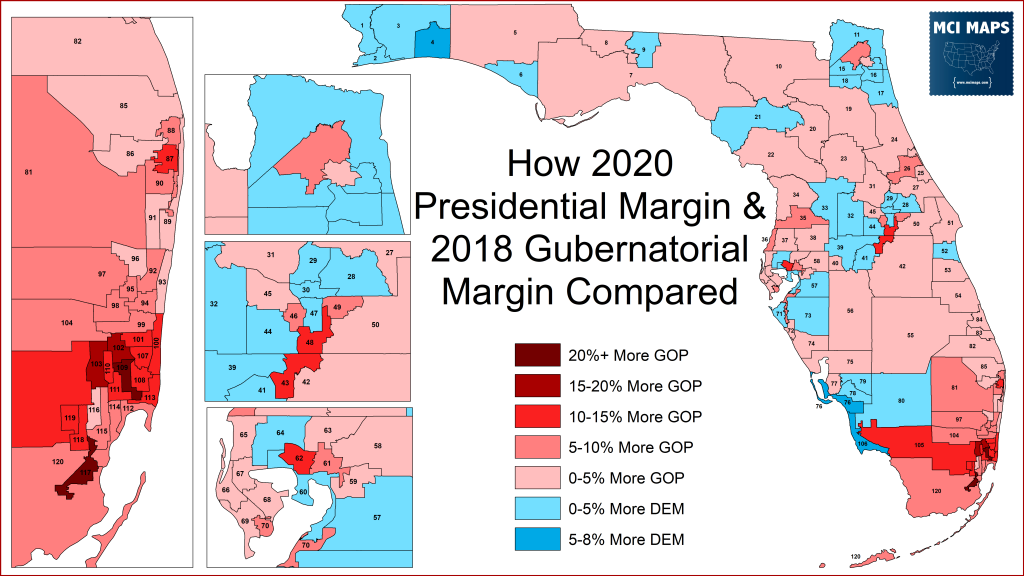
When Gillum and Nelson lost in 2018, I wrote about their problems with Hispanic voters and the drop from 2016 that had occurred. The massive drops continued into 2020.
Another way to look at Biden’s problems was how he compared to 2016 Florida Senate candidate Patrick Murphy. In that election, Murphy lost by 7% to Marco Rubio. Despite doing better than Murphy, Biden was still lower in multiple working-class districts (34th, 35th, 27th), rural districts (10th, 7th, 55th, 5th) and several Hispanic seats (118th, 119th, 103rd).
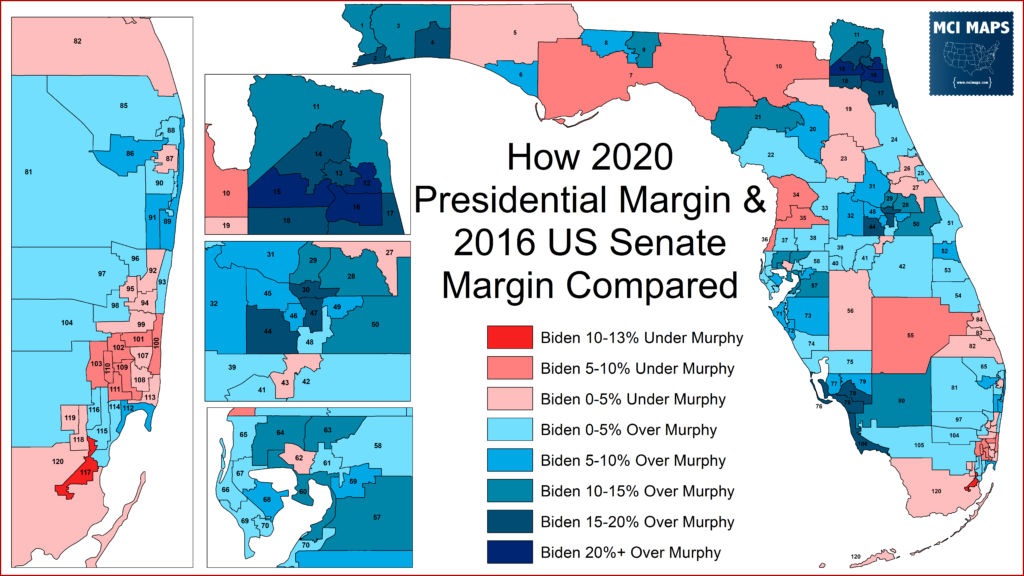
The suburban swing really stands out in that map – showing just how far GOP fortunes have fallen in educated suburbs. However, the drops in working class and rural districts show the Democratic problems weren’t limited to non-whites.
District-Level Results
The Hispanic swing for Trump, to me, was best seen in HD103 – a seat covering part of Hialeah and Miramar. Trump lost the seat by 19% and in 2018, Cindy Polo became the first democrat to win the seat. I thought she was fine for re-election. However, with Trump’s 28% swing, he won the seat by 7% and Polo lost by a little less.
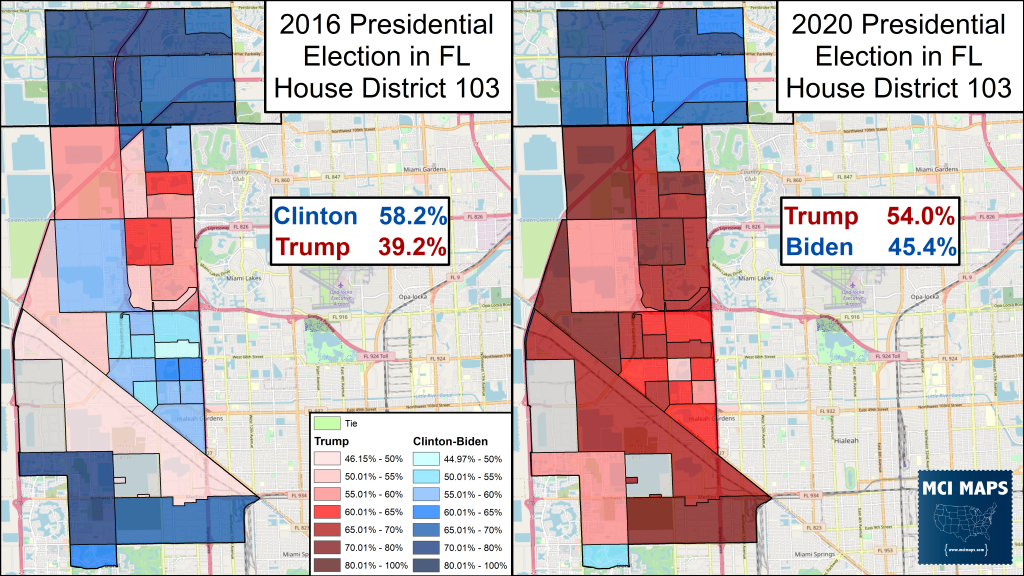
Of course, Hispanic districts weren’t the only areas to swing to the right. African-American areas had different levels of swing – some to Biden and some to Trump. Among the majority-black house districts, Biden improved in two, Trump improved in 4. But in all districts, Biden underperformed Gillum and Clinton’s 2018 performances for Governor and Senator. Biden’s improvements in the Tallahassee-based 8th and Jacksonville-based 14th were in areas with little Caribbean population. Meanwhile, more Caribbean heavy districts like the 95th, 108th, and 107th all saw a more notable right-wing swing.

Caribbean voters were indeed a major battleground block – with Republicans aiming to improve their margins there. It must be noted the 108th and 107th also have high Hispanic minority populations – which add to their swing. But precinct data does point to modest GOP swings in Haitian areas (but less so in Jamaican areas – which populate more of the 95th). Expect more detailed looks at Caribbean voting patterns in a future article.
Biden’s best gains came in suburbs and urban areas. One of the districts to flip to him was HD-15, which covers the SW corridor of Jacksonville. This seat swung 8 points to narrowly back Biden – the biggest swing that led to a flip.
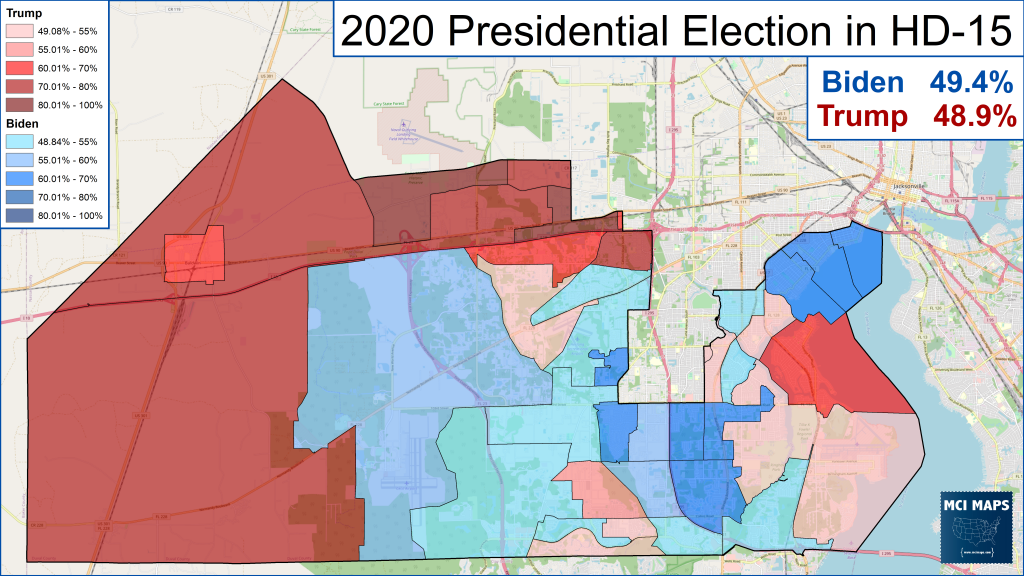
The biggest swing came from the HD-57, located in the southeast corner of Hillsborough. The district swung 9 points to the left, going from Trump +12 to just Trump +3. The reason for this is actually fairly unique. While some populations shifts – the biggest factor was the district had the largest increase in new voters. Big subdivisions were built in the western portions of the district – and these voters were much more democrat-aligned. The result was a surge in democratic votes as the makeup of the district’s population changed.
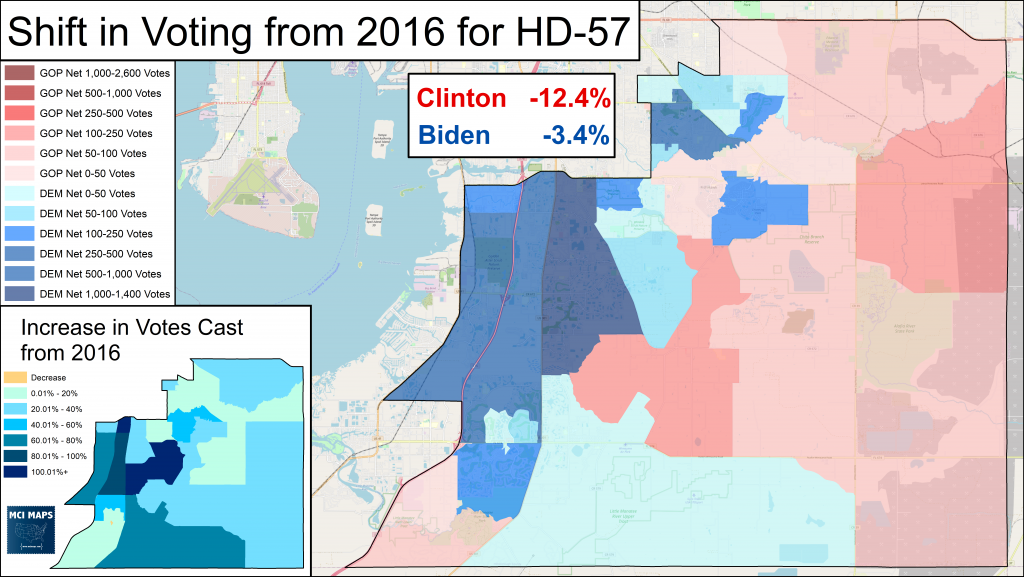
Biden made gains in 8 of the 10 most educated districts in the state. Most of these are largely white. The biggest exception was the 104th, which is plurality Hispanic (located in western Broward) and has a sizable Venezuelan and Columbian minority population. As a result, the 104th, while democratic, swing heavily to the right. The lone other right-wing swing was the 89th, which covers the upper-income coast of Palm Beach.
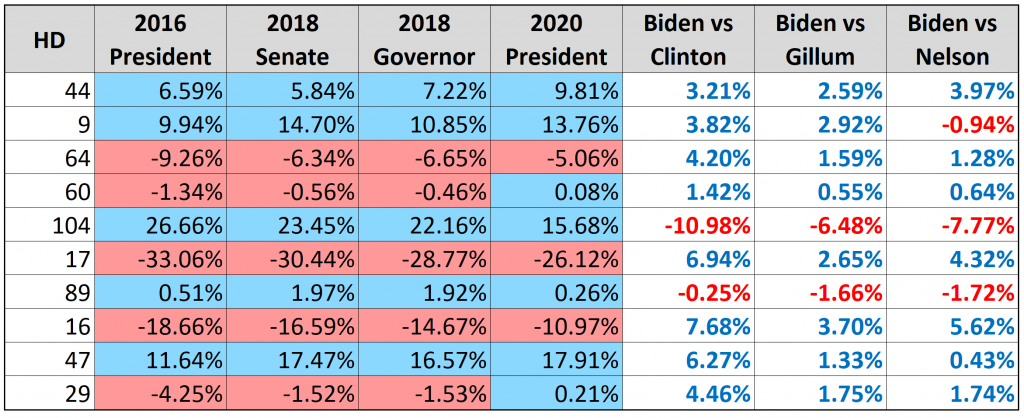
Biden improving in 8 of these 10 districts (and flipping 2) can be seen as good for him, but these swing’s were also fairly small and not enough to offset the big Hispanic losses or make up for working-class losses over previous years. Realistically, a Biden win statewide required bigger swings than these low single-digit shifts.
Battle for the State House
In the 2018 midterm, Democrats had gained 5 seats, bringing them up to 47 of 120. Democrats have not been close to a majority in the chamber for many years. The party was hoping to make more gains in 2020, but taking the chamber was always out of the question. A group of left-wing activists from in and out of the state worked to recruit democratic candidates to all GOP-held districts. They succeeded in all but HD-5 (where the qualifying paperwork was wrong). However, an overwhelming majority of these recruits had no money or backing, and amounted to just names on a ballot. I went through every race in my house ratings article.
Despite Democratic hopes to make gains, the results were a disaster for the party. No flips happened and Democrats instead lost five seats.
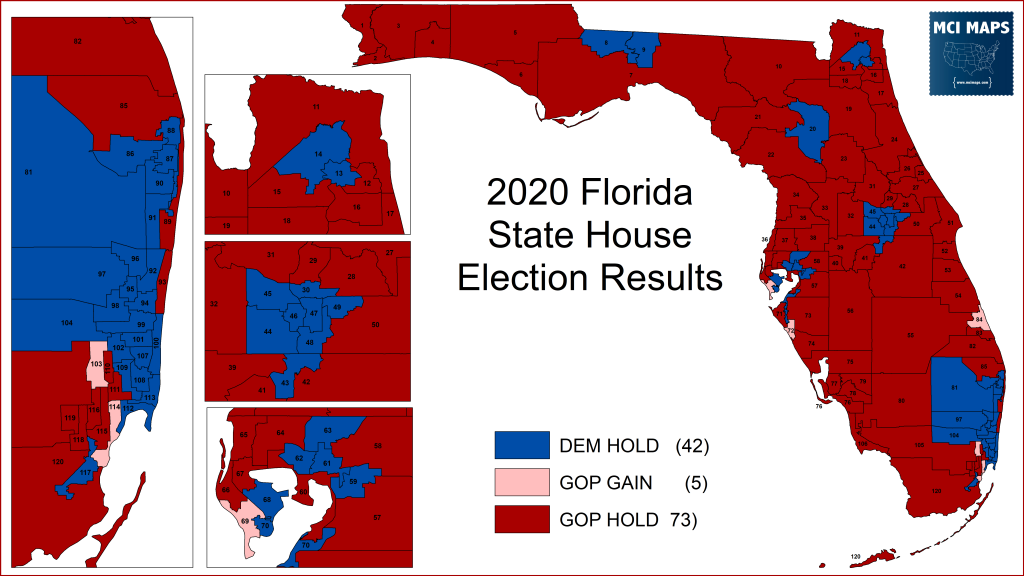
Republicans defeated incumbents in 69, 84, and 103 – while taking the open 72nd and 114th.
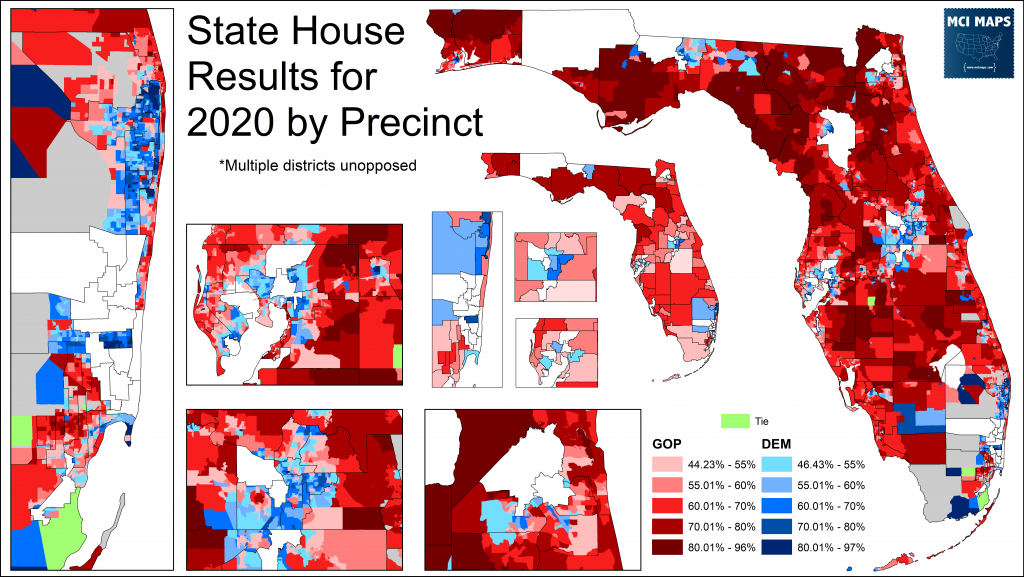
Comparing the membership to the Presidential results actually reveals some of the smallest ticket splitting in history. Granted a large reason for this is Trump winning the many Dade Hispanic seats that would vote for Clinton or Obama but GOP locally over the last decade and a half. This time, only a handful of suburban-aligned districts backed Biden but retained their GOP representatives – despite Democrats aiming to flip all 5 that year.
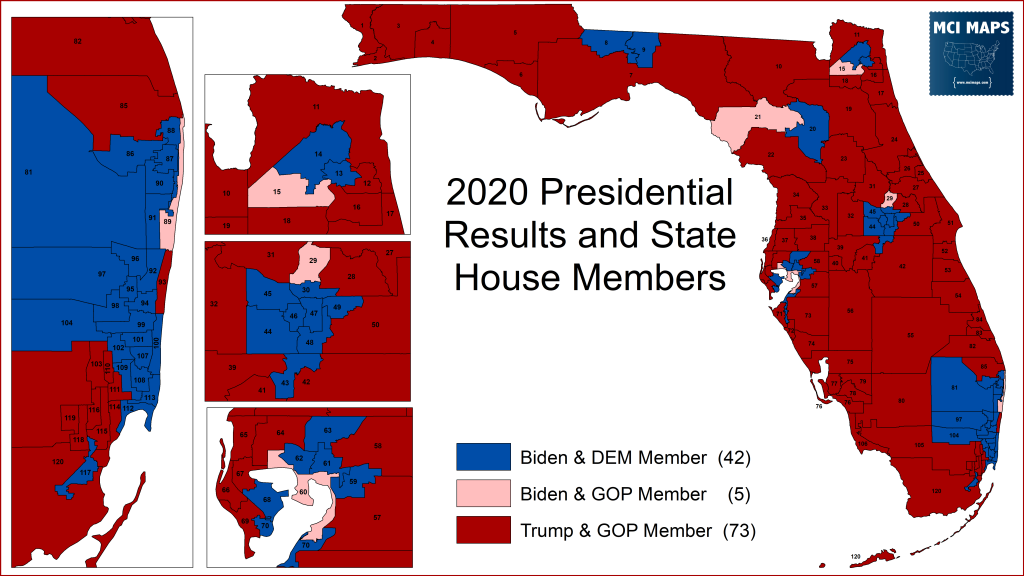
The state house elections heavily correlated with the Presidential results – with a 96% correlation. Overall most Democratic candidates trailed Biden by just a little bit.
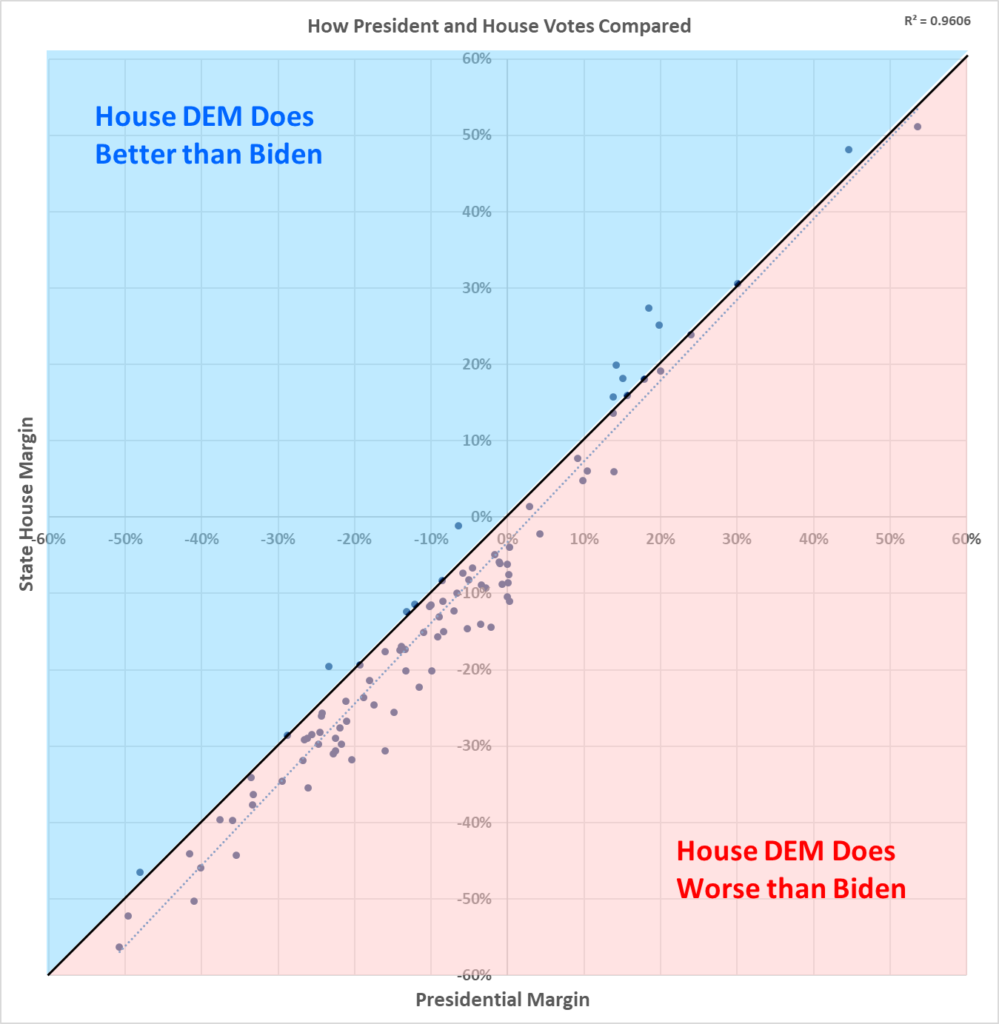
The precinct-level difference between President and House candidates can also been seen below.
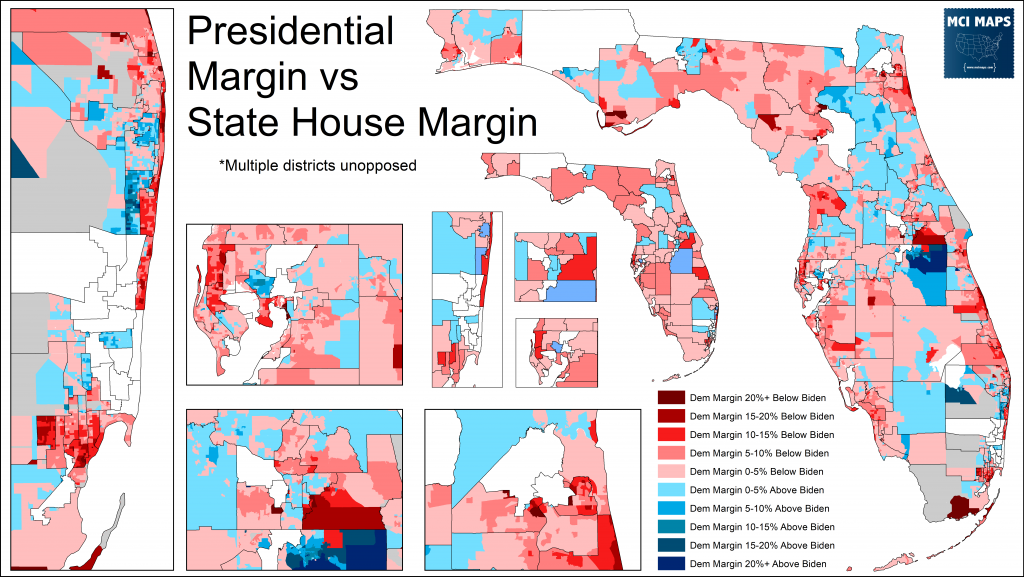
I wanted to go over some of the most notable over or under-performances for the respective house districts vs President
Worst Performing Democrats vs Biden
- HD-119 (Trump +16, GOP Rep +31) — Republican Juan Fernandez-Barquin easily beat Democratic candidate Imtiaz Ahmad Mohammad. This was a one-sided race, with Barguin having all the money and Mohammad recruited to run but had no real money or campaign. This is also an overwhelmingly Hispanic district with a non-Hispanic challenger.
- HD-50 (Trump +2, GOP REP +14) — Republican Rene “Coach P” Plasencia is a strong incumbent in this Orlando-based seat. One of the more moderate Republicans, Plasencia has been overperforming in races since 2014. His challenger, Nina Yoakum, had raised over $80,000 and had third-party backing, but clearly Plasencia’s brand is strong.
Best Performing Democrats vs Biden
- HD-91 (Biden +18, DEM REP +27) — Democrat Emily Ann Slosberg was always a lock to win re-election to her seat. She’s held this district since 2016, when her father, Irv Slosberg, ran for Senator. The Slosberg name is strong here. Her opponent was a FAU student, Sayd Hussain, who did manage to raise around $30,000. However, Slosberg’s name and experience made her a lock. In addition, the district has a large Jewish population – and evidence does point to Biden losing some ground with Jewish retirees (more to be written about this in the future) while Slosberg and other local Jewish politicians didn’t lose the same ground.
- HD-62 (Biden +14, DEM REP +20) — Democrat Susan Valdes easily won her re-election with 57% of the vote, which was actually barely higher than Biden’s 56%. However, what helped Valdes was an NPA candidate taking 4%. This Hispanic-plurality districts in Tampa saw a massive decline for Biden, but Valdes did a better job retaining support despite an Hispanic NPA taking some votes.
One other district to look at
- HD-42 (Trump +6, GOP Rep +1) — This GOP-held district almost flipped thanks to the problems with the GOP candidate. This 52% white, 30% Hispanic seat based in parts of Osceola and Polk had a scandal with GOP-nominee Fred Hawkins. An outgoing county commissioner, Hawkins had been arrested for impersonating a sheriff’s deputy to try and get into a homeowners association meeting. Hawkins was suspended from the commission and almost lost the primary despite being the only candidate with money. What should have been an easy win turned into a close contest as Hawkins pled out on the case. In the end, Hawkins narrowly won. On the precinct map you see him really underperform in the St Cloud region of Osceola while holding the GOP line better in Polk.
Conclusion
With redistricting coming up, Democrats shouldn’t have much faith in a fairer map than the last decade. The biggest redistricting fights will likely revolve around the state senate and congressional maps. The GOP’s majority will make a house gerrymander easily (even with most district’s looking fairly compact).

